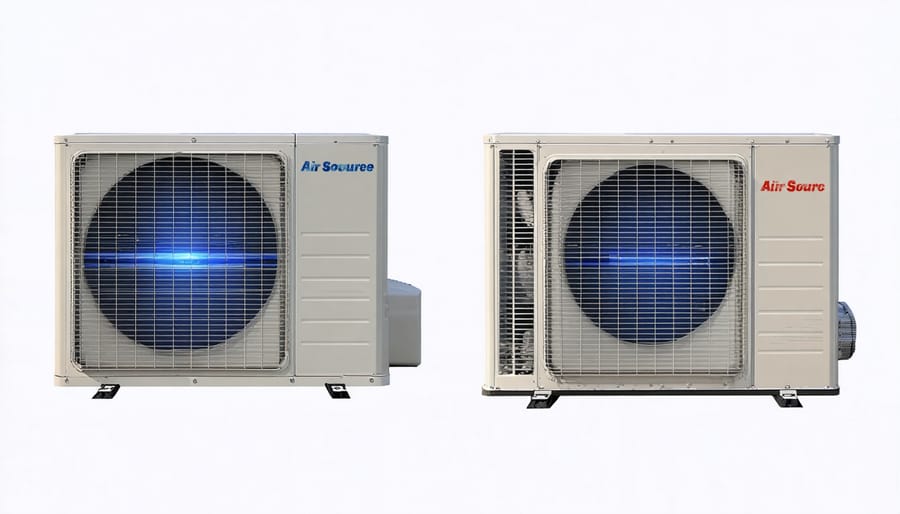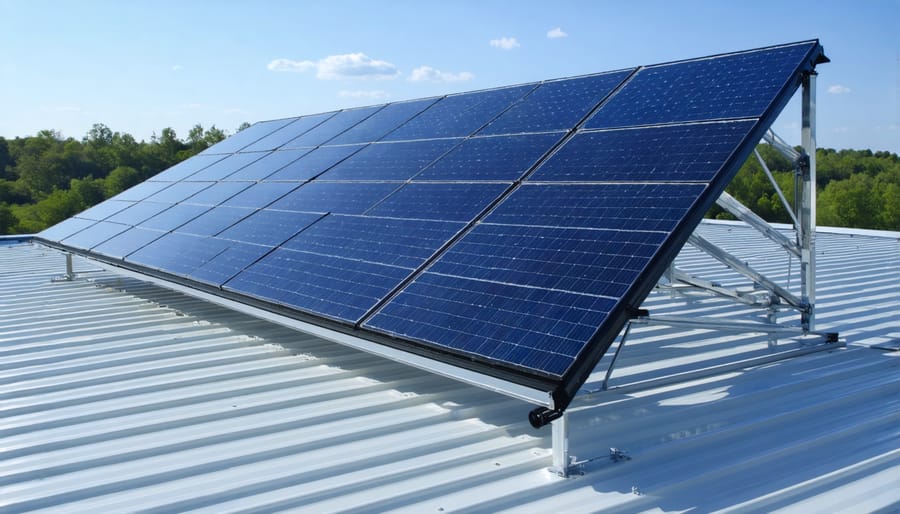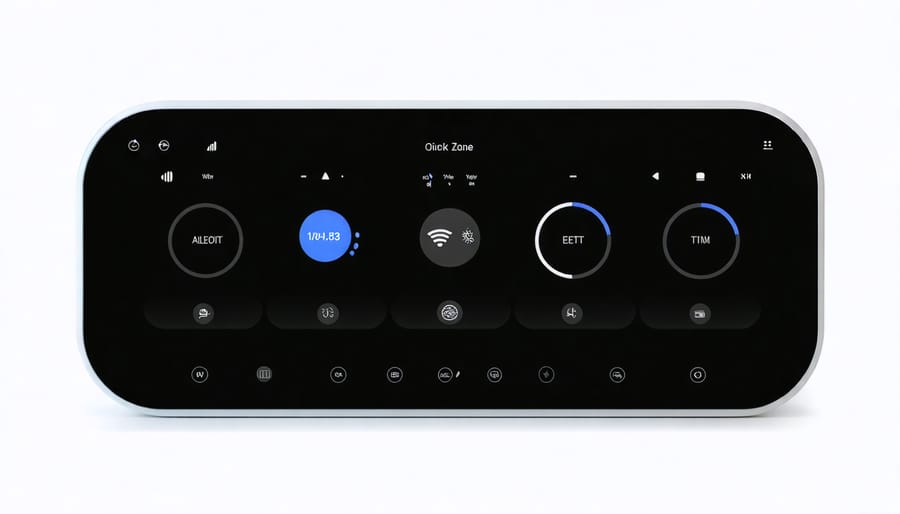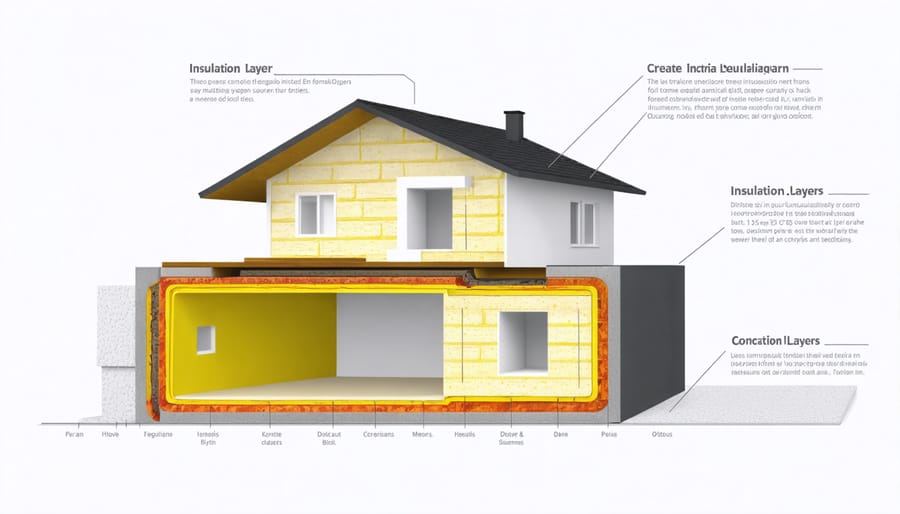Transform your home’s heating system into a sustainable powerhouse by implementing proven solutions that slash energy costs while protecting our planet. Modern energy-efficient home design has revolutionized how we approach heating, offering innovative options that combine comfort with environmental responsibility.
Heat pumps now deliver up to 400% efficiency compared to traditional furnaces, extracting free thermal energy from the air or ground to warm your living spaces. Solar thermal systems can reduce heating bills by 50-80% while eliminating fossil fuel dependency, working seamlessly alongside existing infrastructure. Smart zoning systems and programmable thermostats cut energy waste by up to 30%, directing heat only where and when you need it.
The switch to sustainable heating isn’t just about environmental impact – it’s a practical investment that pays dividends through reduced utility bills and increased property value. Whether you’re renovating an existing home or planning new construction, today’s sustainable heating solutions offer proven pathways to a more comfortable, cost-effective, and environmentally conscious living space.
With government incentives and improved technology driving down installation costs, there’s never been a better time to embrace sustainable heating. These solutions combine cutting-edge efficiency with reliable performance, ensuring your home stays cozy while minimizing its carbon footprint.
Heat Pumps: The Future of Home Heating
Air Source Heat Pumps
Air source heat pumps are becoming increasingly popular as an eco-friendly heating solution, and for good reason. These clever systems work by extracting heat from the outside air – yes, even in cold weather – and using it to warm your home efficiently.
Think of an air source heat pump as a refrigerator working in reverse. Instead of removing heat from inside a space, it captures heat from the outdoor air and transfers it indoors. Even when it’s chilly outside, there’s still enough heat energy in the air for these systems to work effectively.
The initial cost of installing an air source heat pump typically ranges from $4,000 to $8,000, depending on your home’s size and specific requirements. While this might seem like a significant investment, many homeowners find the long-term savings worthwhile. These systems can reduce heating costs by 30-50% compared to traditional electric heating.
When it comes to efficiency, air source heat pumps really shine. Most modern units achieve a Coefficient of Performance (CoP) of 3 or higher, meaning they produce three units of heat energy for every unit of electricity consumed. This impressive efficiency makes them an excellent choice for environmentally conscious homeowners.
Installation is relatively straightforward, requiring an outdoor unit (similar to an AC unit) and an indoor unit to distribute the heat. The system works best in well-insulated homes and can provide both heating and cooling, making it a versatile year-round solution.
Pro tip: Regular maintenance, including keeping the outdoor unit clear of debris and scheduling annual professional check-ups, will help ensure your heat pump operates at peak efficiency.

Ground Source Heat Pumps
Ground source heat pumps, also known as geothermal heating systems, are one of the most efficient sustainable heating solutions available today. These systems tap into the earth’s constant underground temperature to heat your home in winter and cool it in summer, offering remarkable energy efficiency and long-term cost savings.
Think of the earth as a giant thermal battery. Just a few feet below the surface, the ground maintains a steady temperature of around 50-60°F (10-15°C) year-round. A ground source heat pump takes advantage of this stability by circulating a mixture of water and environmentally-friendly antifreeze through underground pipes, called ground loops.
The initial installation cost of a geothermal system might make you pause – it typically ranges from $15,000 to $35,000 for a residential installation. However, the long-term benefits are impressive: these systems can reduce your heating and cooling costs by 30-60% compared to traditional systems. Many homeowners see a return on investment within 5-10 years through energy savings.
Beyond the financial benefits, ground source heat pumps offer several advantages:
– Extremely quiet operation
– Long system lifespan (20-25 years for indoor components, 50+ years for ground loops)
– Minimal maintenance requirements
– No outdoor unit to worry about
– Reduced carbon footprint
– Consistent comfort levels throughout your home
While installation requires careful planning and professional expertise, these systems work in most climates and can be installed in both new construction and existing homes. The only major requirement is sufficient yard space for the ground loop installation, which can be laid either horizontally or vertically depending on your property’s characteristics.
Solar Thermal Solutions
Active Solar Heating
Active solar heating harnesses the sun’s energy through specialized collectors, making it an excellent addition to zero energy home solutions. These collectors typically consist of dark-colored panels that absorb sunlight and convert it into heat, which is then transferred to a fluid (usually water or air) circulating through the system.
The two main types of solar collectors are flat-plate and evacuated tube collectors. Flat-plate collectors are the more common choice for home heating, featuring an insulated box with a dark absorber plate under glass or plastic covers. Evacuated tube collectors use parallel rows of glass tubes and tend to be more efficient, especially in colder climates.
Once the heat is collected, it’s distributed throughout your home using either a liquid-based or air-based system. Liquid systems pump heated water or antifreeze through radiant floor heating or baseboards, while air systems use fans to circulate warm air through your existing ductwork.
The beauty of active solar heating lies in its simplicity and effectiveness. While initial installation costs may be higher than traditional heating systems, the long-term savings on energy bills make it a smart investment. Plus, many regions offer tax incentives and rebates for installing solar heating systems, making the transition to solar even more appealing.

Passive Solar Design
Imagine your home as a natural heat collector, working with the sun to keep you cozy during cold months. That’s the essence of passive solar design – a smart approach that uses architectural elements to harness the sun’s warmth without any mechanical systems.
The key to effective passive solar design lies in strategic window placement. South-facing windows capture maximum sunlight during winter months, while carefully planned roof overhangs prevent overheating in summer. These windows should be high-performance, double or triple-paned to retain heat effectively.
Thermal mass materials like concrete floors, brick walls, or tile play a crucial role by absorbing heat during the day and releasing it slowly at night. Think of them as natural heat batteries for your home. Dark-colored surfaces in direct sunlight can increase heat absorption, making your space even more efficient.
Proper insulation and air sealing are essential companions to passive solar design. They ensure that the captured heat stays where you want it – inside your home. Consider adding thermal curtains or blinds to provide additional control over heat gain and loss.
The beauty of passive solar design is its simplicity – once implemented, it works silently and freely, reducing your heating needs by up to 40%. Whether you’re building new or renovating, incorporating these elements can create a naturally comfortable living space while significantly lowering your energy bills.
Smart Heating Controls
Smart Thermostats
Smart thermostats are revolutionizing how we manage our home’s heating, serving as the brain of modern smart home automation systems. These intuitive devices learn your temperature preferences and daily routines, automatically adjusting your home’s climate for optimal comfort and energy efficiency.
The real magic happens through features like geofencing, which tracks your location to adjust temperatures when you’re away, and smart scheduling that adapts to your lifestyle. Many models can even detect open windows or respond to local weather forecasts, making micro-adjustments that add up to significant energy savings.
Installing a smart thermostat typically leads to a 10-15% reduction in heating costs. Beyond the financial benefits, these devices provide valuable insights through user-friendly apps that track your energy consumption and offer personalized tips for improvement. You can control the temperature from anywhere using your smartphone, ensuring you never waste energy heating an empty house.
Most smart thermostats are surprisingly easy to install yourself, though professional installation is always an option. Look for models that offer compatibility with your existing heating system and other smart home devices. Some utility companies even offer rebates for installing these energy-efficient devices, making them an even more attractive investment for sustainable living.

Zoned Heating Systems
Imagine having the perfect temperature in every room of your house while saving energy and money. That’s exactly what zoned heating systems deliver. Instead of heating your entire home to one temperature, these smart systems let you control different areas independently.
Think of your home as having different “zones” – perhaps a cozy living room, a cooler bedroom for sleeping, and a warm bathroom for those chilly morning showers. Each zone gets its own thermostat, allowing you to heat only the spaces you’re using, when you’re using them.
Setting up a zoned system is easier than you might think. Start by identifying your home’s natural zones based on usage patterns and room locations. Install programmable thermostats in each zone and connect them to your heating system through dampers in your ductwork or individual heating units.
Pro tip: Consider your daily routine when programming temperatures. Set your bedroom cooler at night and warmer in the morning, keep your home office comfortable during work hours, and reduce heat in unused rooms.
The beauty of zoned heating lies in its efficiency. By heating only the spaces you need, you can reduce your energy consumption by up to 30%. Plus, you’ll eliminate those frustrating hot and cold spots that make some rooms uncomfortable while others are perfect.
Remember to maintain your system regularly and check for leaks in ductwork to ensure maximum efficiency. With proper setup and maintenance, zoned heating can transform how you experience comfort at home while supporting your sustainable living goals.
Insulation and Heat Recovery

Modern Insulation Solutions
Today’s eco-friendly insulation solutions have come a long way from traditional fiberglass. Smart homeowners are now embracing innovative materials that not only keep their homes cozy but also minimize environmental impact.
Aerogel insulation, once used primarily in spacecraft, is now making its way into homes. This ultra-light material offers superior insulation with minimal thickness, perfect for spaces where every inch counts. While it’s currently on the pricier side, its effectiveness makes it a worthwhile investment for long-term energy savings.
Recycled denim insulation is gaining popularity among environmentally conscious homeowners. Made from post-consumer jean scraps, it’s non-toxic, safe to handle, and provides excellent sound dampening alongside thermal insulation. It’s a fantastic choice for those wanting to reduce their carbon footprint while maintaining optimal home comfort.
Vacuum insulated panels (VIPs) represent another breakthrough in insulation technology. These slim panels create an almost perfect thermal barrier, requiring just a fraction of the thickness of traditional materials. Though primarily used in new constructions, they’re increasingly being incorporated into renovation projects.
For a more natural approach, hemp insulation offers remarkable performance. It’s moisture-resistant, naturally pest-repellent, and completely biodegradable. Plus, hemp grows quickly without pesticides, making it one of the most sustainable insulation options available.
Remember, proper installation is crucial regardless of the material you choose. Consider consulting a professional to ensure you get the maximum benefit from these modern insulation technologies.
Heat Recovery Ventilation
Ever wondered how to keep your home warm without letting all that precious heated air escape? Heat Recovery Ventilation (HRV) systems are your answer. These clever systems work like the lungs of your home, bringing in fresh air while keeping the warmth where it belongs – inside your living space.
Here’s how it works: as stale air exits your home, the HRV system captures up to 85% of its heat before it escapes. This recovered heat is then used to warm the incoming fresh air, ensuring you maintain both comfort and air quality. It’s like having a thermal recycling system working around the clock!
The benefits are impressive: you’ll enjoy better indoor air quality, reduced energy bills, and fewer issues with condensation and mold. Plus, these systems are particularly effective in well-insulated homes where air circulation might otherwise be limited.
Installing an HRV system is a bigger project that typically requires professional help, but the long-term savings make it worthwhile. Modern units come with smart controls that adjust ventilation based on your home’s needs, and some even include humidity sensors to maintain optimal comfort levels.
Pro tip: Regular maintenance is key to keeping your HRV system running efficiently. Clean or replace filters every few months, and check the exterior vents seasonally to ensure they’re clear of debris. This simple upkeep will help your system perform at its best while keeping your energy bills in check.
Cost Analysis and Incentives
Installation Costs vs. Long-term Savings
While sustainable heating solutions often come with higher upfront costs, they can significantly reduce energy costs over time. Let’s break down what you can expect:
Heat pumps typically cost between $4,000 and $8,000 for installation, but they can save you 30-60% on annual heating bills, with a payback period of 5-7 years. Solar thermal systems, while pricier at $8,000-$10,000, often pay for themselves within 7-10 years through energy savings and available tax incentives.
Biomass boilers, ranging from $5,000 to $12,000, offer shorter payback periods of 4-6 years, especially in areas with access to affordable wood pellets. Geothermal systems, though the most expensive at $15,000-$25,000, provide the highest long-term savings and can last up to 50 years with minimal maintenance.
Remember, many governments offer rebates and tax incentives that can significantly reduce initial costs. Plus, these systems typically increase your home’s value, making them a smart long-term investment for both your wallet and the planet.
Government Rebates and Programs
Making the switch to sustainable heating is more affordable than ever, thanks to numerous government incentives and programs. The federal government offers tax credits of up to 30% through the Energy Efficient Home Improvement Credit for qualifying heat pump installations and other sustainable heating upgrades.
Many states provide additional rebates ranging from $500 to $10,000 for installing energy-efficient heating systems. For example, some areas offer point-of-sale rebates for heat pumps, while others provide low-interest financing options for solar thermal systems.
Local utility companies often run their own incentive programs, including cash rebates, equipment discounts, and seasonal promotions. Some even offer free energy audits to help you identify the most cost-effective sustainable heating solutions for your home.
To maximize your savings, consider combining multiple incentives. Visit your state’s energy office website or DSIRE (Database of State Incentives for Renewables & Efficiency) to explore available programs in your area. Remember that these programs often change annually, so it’s worth checking regularly for new opportunities.
As we’ve explored throughout this guide, sustainable heating solutions offer more than just environmental benefits – they’re a smart investment in your home’s future and your family’s comfort. From energy-efficient heat pumps to solar thermal systems, these technologies can significantly reduce both your carbon footprint and monthly energy bills.
Remember, making the switch to sustainable heating doesn’t have to happen all at once. Start with simple steps like improving your home’s insulation or installing a smart thermostat. As you become more comfortable with these changes, you can gradually implement more comprehensive solutions that align with your budget and lifestyle.
The initial investment in sustainable heating might seem daunting, but consider the long-term savings and available incentives. Many governments offer tax credits and rebates for eco-friendly heating installations, making the transition more affordable than ever.
By choosing sustainable heating solutions, you’re not just creating a more comfortable living space – you’re contributing to a healthier planet for future generations. Whether you’re ready to completely overhaul your heating system or just starting to explore your options, every step toward sustainability matters.
Take action today by scheduling an energy audit or consulting with heating professionals about the best sustainable solutions for your home. Your journey toward efficient, environmentally friendly heating starts with that first step.
